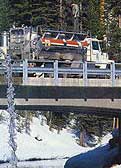





 |
 |
 |
 |
 |
|||
 |
At this stage they are gently herded to screened gates at the end of the raceways (figure 1&2). Hatchery personnel do the herding using hand-held seines.
Fish are encouraged to pass out of the raceways and into a collection basin located at the far end of the outdoor ponds. This basin is supplied by the outflowing water from the raceways.
A vacum pump is attached to an outlet at the far left corner of the collection basin, and the fish are guided towards it (figure 3).The pump sucks the smolts out of the basin and into a large, water-filled tanker (figure 4&5).
The tanker then transports the smolts back to the South Fork Station where they are released into the Salmon River, ready to begin their long journey downstream to the Pacific.
Upon release, the young chinook imprint their "natal stream" onto their memory. It is believed that they do this using their acute sense of smell (their olfactory systems are sensitive to the parts per billion [ppb] level). This memory, combined with their strong homing instinct is thought to guide adult fish back to their "spawning" ground.
The journey to the Pacific takes an average of two months. High mortality occurs as a result of dams, predation, disease and other hazards. Surviving chinook spend an average of two years in the ocean, then begin the long journey back upriver to the South Fork Station where a number of adults are trapped, and the McCall hatchery cycle begins again.